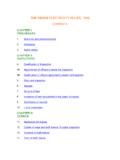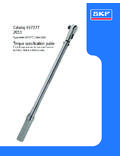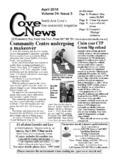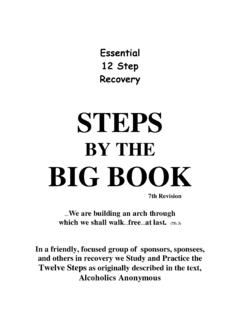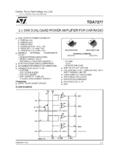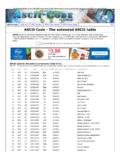Transcription of BRAND IMAGE AND BRAND ASSOCIATIONS DR …
1 1 BRAND IMAGE AND BRAND ASSOCIATIONS DR CERESSEC 00024 MICHAEL KORCHIA Doctoral Student at ESSEC (France), Graduate School of Economics and Management This paper was downloaded from 2 R sum : La d finition de l IMAGE de marque de Keller (1993) comme tant les perceptions portant sur une marque refl t es par les ASSOCIATIONS la marque d tenues dans la m moire du consommateur est adopt e. Cependant, sa typologie de l IMAGE de marque, ainsi que celle de Aaker (1991), comportent des faiblesses. Une nouvelle typologie de l IMAGE de marque est pr sent e et est valid e empiriquement l aide de la m thode de l licitation libre. Abstract : Keller s (1993) definition of BRAND IMAGE as "perceptions about a BRAND as reflected by the BRAND ASSOCIATIONS held in consumer memory" is adopted in this paper. However, both his typology of BRAND IMAGE and Aaker's typology (1991) are shown to have some weaknesses.
2 In this paper I introduce a new typology of BRAND IMAGE that addresses the weaknesses in these typologies. Mots-clefs : IMAGE de marque, structures cognitives, M moire, connaissances du consommateur Keywords : BRAND IMAGE , Cognitive Structures, Memory, Consumer Knowledge 3 BRAND IMAGE AND BRAND ASSOCIATIONS1 Most researchers and practitioners agree about the importance of stressing BRAND IMAGE . Aaker (1991), for example, says IMAGE creates value in a variety of ways, helping consumers to process information, differentiating the BRAND , generating reasons to buy, giving positive feelings, and providing a basis for extensions. However, there is still a lack of agreement about the definition of BRAND IMAGE (Dobni & Zinkhan, 1990). Keller s (1993: 3) definition, although it has not, to my knowledge, been tested yet, seems to be a major contribution in this domain.
3 His definition of BRAND IMAGE as "perceptions about a BRAND as reflected by the BRAND ASSOCIATIONS held in consumer memory" is consistent with many other authors (Newman, 1957; Dichter, 1985; Aaker, 1991; Engel, Blackwell & Miniard, ); A more simple definition could be "all that a consumer can possibly associate with a particular BRAND ." Mitchell (1982: 46, for a review) considers memory an associative network model: "within this model, the nodes of the network represent concepts while the arcs are linkages (that also define relationships) between concepts." As Keller notes, these ASSOCIATIONS (figure 1) can vary in strength (which makes information more accessible), favorability, and uniqueness (the degree to which this association is not shared with other competing brands). Sirgy (1981) thinks that these ASSOCIATIONS can be characterized by at least eleven dimensions.
4 Accordingly, this associative network of knowledge for a BRAND is the IMAGE of this BRAND (Engel, Blackwell & Miniard, 1995) as stored in the long-term memory, which is defined as "a subcomponent of memory which is permanent, virtually unlimited in storage capacity, and well stored" (Dacin & Mitchell, 1986). BRAND ASSOCIATIONS are all the linkages that exist between a BRAND and the other nodes stored in 1 Contact the author for a lenghtier version of this paper 4 memory. In measuring the structure (how information related to a BRAND is organized in memory) and the content ( BRAND ASSOCIATIONS ) of an associative network of knowledge that a consumer holds for a BRAND , the perception the consumer has of the BRAND is also measured. FIGURE 1 Possible Simplified Associative Network of Knowledge for Pepsi (inspired by Keller, 1993) PepsiSoft DrinkCaffeinAd / MichaelJacksonSugar Note that this view is consistent with the belief that knowledge is organized into packets of information (Mitchell, 1982).
5 For example, schemata are packets of information centered around concepts. As Olson (1979: 5) notes, "the schema notion implies that memory is comprised of many highly organized structures of knowledge or schemata, and is not a vast storage bin into which all coded information is dumped ". EXISTING TYPOLOGIES OF BRAND IMAGE In this paper, the word " BRAND " is restricted to companies that sell consumer goods. Thus, organizations, charity funds and so forth do not match this definition. Several ways to classify knowledge have been proposed, including the distinction between declarative versus procedural knowledge (Anderson, 1983). Declarative knowledge involves the facts that are known about a particular domain, whereas procedural knowledge refers to the 5 knowledge of rules to take action. However, to study the perception of brands, the researcher, as well as the practitioner, needs a more relevant typology.
6 Keller (1993) considers BRAND IMAGE and BRAND awareness ( BRAND recall and recognition) to be the two components of BRAND knowledge. He classifies BRAND ASSOCIATIONS (and therefore BRAND IMAGE ) into three categories that fall along a continuum from concrete to abstract. 1. Attributes: Keller distinguishes between non-product-related attributes (price, packaging, user imagery, usage imagery; the last two can also produce BRAND personality attributes) and product-related attributes. 2. Benefits: functional (often linked to physiological needs), experiential (what it feels like to use the product), and symbolic (one example : a need for social approval or self-esteem). See Park, Jaworski, & MacInnis (1986) for more details. 3. BRAND attitudes, defined as consumers overall evaluations of a BRAND . Aaker (1991) makes another important contribution with his typology, distinguishing between 11 dimensions: product attributes, intangibles, customer benefits, price, use/ application, user, celebrity, life style, product class, competitors, and country of origin.
7 Aaker s and Keller s typologies share many common categories (see Delamotte, 1996, for a review): price, user imagery, usage imagery, and product attributes. I will show that both have some weaknesses, but first consider how it is possible to tap the content of a consumer s THE FREE ELICITATION PROCEDURE It is widely accepted that a "spreading activation" process occurs when retrieving information stored in memory ( Collins & Loftus, 1975; Keller, 1991; Mitchell, 1982). When the amount 6 of activation at a node exceeds some threshold level, the information contained in this node is recalled. When a node is activated, the nodes most strongly linked with this node are more likely to be activated. Olson and Muderrisoglu (1978: 7) define the free-elicitation method as "a procedure in which respondents are free to say anything and everything that comes to mind when presented with a stimulus probe cue.
8 " A very general probe attempts to activate a memory schema without inducing any particular answer. When the probe is a BRAND name, the objective is to activate all the nodes associated with this name in the subject s memory2. However, as subjects are not likely to recall everything they know about a BRAND in response to a single probe, a multiple elicitation procedure (Brucks, 1986; Finlay, 1996; Kanwar, Olson & Sims, 1979; Olson, 1979) may be used in which each elicited concept is itself subsequently used as a probe. This procedure continues as long as the subject is able to verbalize new concepts. The elicitation procedure has been shown to be the best way to measure both the content and the structure of knowledge within a domain, because it is quite stable and reliable and it allows researchers to tap most of the content of a subject s knowledge about a domain (Olson & Muderrisoglu 1978; Finlay, 1996).
9 A study by Steenkamp and Van Trijp (1997) suggests that free elicitation is to be preferred to other attribute elicitation procedures (namely hierarchical dichotomization and repertory grid). The interviews must be recorded and transcribed before they can be analyzed. It is possible to analyze them in a variety of ways, depending on the goal of the research. Because the objective of this article is to propose a new typology of BRAND IMAGE , and therefore to describe the different 2 The first statements elicited by a consumer are the most likely to be the strongest ones; also, the concepts that are the most repeated are probably connected to many other concepts, indicating that they are central (Michel, 1997, 1998). However, it goes beyond the scope of this paper to take a further look in this direction: our aim is to clarify the content of a BRAND IMAGE , not to show why people have positive/negative or strong/weak BRAND ASSOCIATIONS 7 kind of BRAND ASSOCIATIONS that may exist, I will discuss only the coding of answers.
10 Coding schemes can be developed to classify as many statements ( ASSOCIATIONS ) as possible. In this case, a coding scheme defines a typology of the domain in question: Bettman and Park (1980) created a coding scheme for classifying the use of prior knowledge during decision making; Brucks (1986) developed a coding scheme to classify consumer product knowledge. Brucks defined (1986: 59) three objectives that a coding scheme (and therefore the associated typology) must satisfy: 1. The typology should cover as many of the subjects statements as possible while remaining relatively parsimonious. 2. The coding scheme and typology should be easy to use and seem logical to people who code the answers. 3. The categories in the typology should be as distinct from one another as possible. A new typology of BRAND IMAGE , taking in account Keller s (1991) and Aaker s (1991) contributions, and designed to satisfy Brucks criteria, has been developed and empirically tested.
